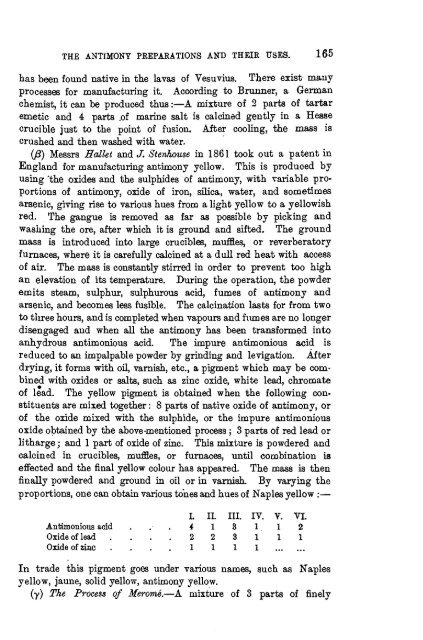antimony - Sciencemadness.org
antimony - Sciencemadness.org
antimony - Sciencemadness.org
Create successful ePaper yourself
Turn your PDF publications into a flip-book with our unique Google optimized e-Paper software.
THE ANTIMONY PREPARATIONS AND THEIR USES. 165<br />
has been found native in the lavas of Vesuvius. There exist many<br />
processes for manufacturing it. According to Brunner, a German<br />
chemist, it can be produced thus:—A mixture of 2 parts of tartar<br />
emetic and 4 parts .of marine salt is calcined gently in a Hesse<br />
crucible just to the point of fusion. After cooling, the mass is<br />
crushed and then washed with water.<br />
(fi) Messrs Hallet and J. Stenhouse in 1861 took out a patent in<br />
England for manufacturing <strong>antimony</strong> yellow. This is produoed by<br />
using *the oxides and the sulphides of <strong>antimony</strong>, with variable proportions<br />
of <strong>antimony</strong>, oxide of iron, silica, water, and sometimes<br />
arsenic, giving rise to various hues from a light yellow to a yellowish<br />
red. The gangue is removed as far as possible by picking and<br />
washing the ore, after which it is ground and sifted. The ground<br />
mass is introduced into large crucibles, muffles, or reverberatory<br />
furnaces, where it is carefully calcined at a dull red heat with access<br />
of air. The mass is constantly stirred in order to prevent too high<br />
an elevation of its temperature. During the operation, the powder<br />
emits steam, sulphur, sulphurous acid, fumes of <strong>antimony</strong> and<br />
arsenic, and becomes less fusible. The calcination lasts for from two<br />
to three hours, and is completed when vapours and fumes are no longer<br />
disengaged and when all the <strong>antimony</strong> has been transformed into<br />
anhydrous antimonious acid. The impure antimonious acid is<br />
reduced to an impalpable powder by grinding and levigation. After<br />
drying, it forms with oil, varnish, etc., a pigment which may be combined<br />
with oxides or salts, such as zinc oxide, white lead, chromate<br />
of lead. The yellow pigment is obtained when the following constituents<br />
are mixed together: 8 parts of native oxide of <strong>antimony</strong>, or<br />
of the oxide mixed with the sulphide, or the impure antimonious<br />
oxide obtained by the above-mentioned process; 3 parts of red lead or<br />
litharge; and 1 part of oxide of zinc. This mixture is powdered and<br />
calcined in crucibles, muffles, or furnaces, until combination is<br />
effected and the final yellow colour has appeared. The mass is then<br />
finally powdered and ground in oil or in varnish. By varying the<br />
proportions, one can obtain various tones and hues of Naples yellow :—<br />
Antiinonious acid<br />
Oxide of lead<br />
Oxide of zinc<br />
In trade this pigment goes under various names, such as Naples<br />
yellow, jaune, solid yellow, <strong>antimony</strong> yellow.<br />
(y) The Process of Merome.—A mixture of 3 parts of finely<br />
I.<br />
i21<br />
II.<br />
1<br />
2 1<br />
III.<br />
331<br />
IV.<br />
111<br />
V.<br />
11<br />
VI.<br />
21
















